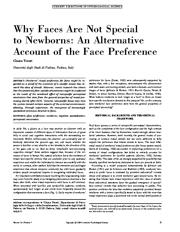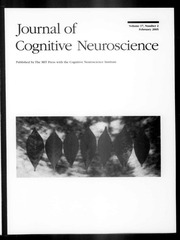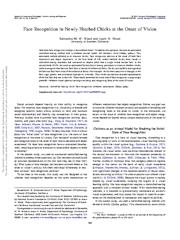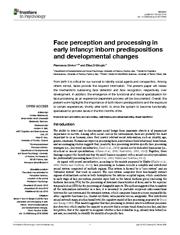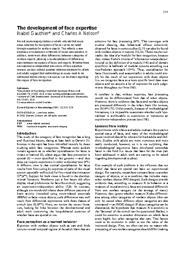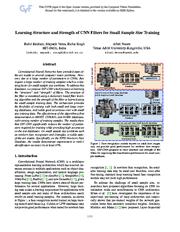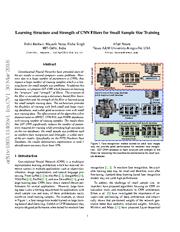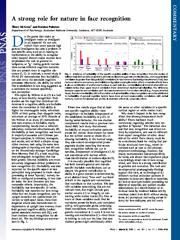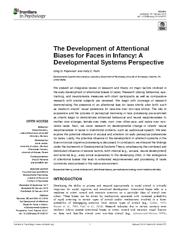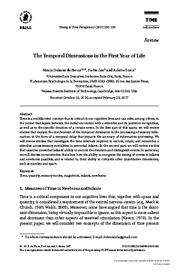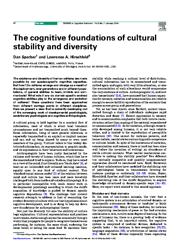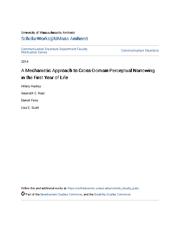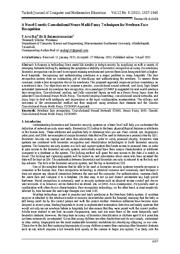A copy of this work was available on the public web and has been preserved in the Wayback Machine. The capture dates from 2017; you can also visit the original URL.
The file type is application/pdf.
Filters
Why Faces Are Not Special to Newborns
2004
Current Directions in Psychological Science
Newborns' visual preference for faces might be regarded as a proof of the existence of a specific innate bias toward this class of stimuli. ...
However, recent research has shown that this putatively face-specific phenomenon might be explained as the result of the combined effect of nonspecific perceptual constraints that stem from the general ...
Macchi Cassia for their precious guidance within this field of research and their indispensable contribution in all phases of the studies discussed here. ...
doi:10.1111/j.0963-7214.2004.01301002.x
fatcat:ry2bykapf5gtndxm3vjap5dbwq
Page 261 of Journal of Cognitive Neuroscience Vol. 17, Issue 2
[page]
2005
Journal of Cognitive Neuroscience
The role of facial orientation in newborn infants’ preference for attractive faces. ...
Domain specificity in face perception Nature Neuroscience, 3, 759-703
Kreiman, G., Koch, C., & Fried, Ll. (2000). ...
What determines whether faces are special?
2003
Visual Cognition
For example, because innateness can be separated from localization and domain specificity, neural systems that are domain specific and localized do not have to be innate because experience-dependent learning ...
However, argues that the effect is consistent with either a domain-general system for both faces and dogs or two domain-specific systems, one for faces and the other for dogs. ...
doi:10.1080/13506280244000050
fatcat:za4grpr3ibhwhmi5mitlpmmlr4
Face recognition in newly hatched chicks at the onset of vision
2015
Journal of Experimental Psychology: Animal Learning and Cognition
How does face recognition emerge in the newborn brain? To address this question, we used an automated controlled-rearing method with a newborn animal model: the domestic chick (Gallus gallus). ...
These results show that the initial state of face recognition is surprisingly powerful: Newborn visual systems can begin encoding and recognizing faces at the onset of vision. ...
Support for this domain-general position comes from studies showing that face memory undergoes domain-specific development during the first 10 years of human life (Weigelt et al., 2014) , that newborns ...
doi:10.1037/xan0000059
pmid:25867056
fatcat:tene52vnmzgzxpq6ffze7wwjbm
Face perception and processing in early infancy: inborn predispositions and developmental changes
2015
Frontiers in Psychology
The present paper will review the mechanisms subserving face detection and face recognition, respectively, over development. ...
From birth it is critical for our survival to identify social agents and conspecifics. Among others stimuli, faces provide the required information. ...
Different interpretations were proposed to account for human newborns' face preference, in terms of both domain-specific or of domain-general mechanisms underlying it. ...
doi:10.3389/fpsyg.2015.00969
pmid:26217285
pmcid:PMC4496551
fatcat:bnl5iqcktverzb5txdyjhk4pyq
The development of face expertise
2001
Current Opinion in Neurobiology
Acknowledgements Isabel Gauthier wishes to thank Jane Zbrodoff for helpful comments. ...
These results contradict the idea of a 'module' for face recognition, because they violate Fodor's criteria of 'information encapsulation' (crucial to the definition of a module [14] ) and of domain specificity ...
as a clear demonstration for a face-specific system [26] . ...
doi:10.1016/s0959-4388(00)00200-2
pmid:11301243
fatcat:zy36saib4fdchk4r7bawlcenem
Learning Structure and Strength of CNN Filters for Small Sample Size Training
2018
2018 IEEE/CVF Conference on Computer Vision and Pattern Recognition
On small sample size problems such as newborn face recognition and Omniglot, it yields stateof-the-art results. ...
Specifically, on the IIITD Newborn Face Database, the results demonstrate improvement in rank-1 identification accuracy by at least 10%. ...
Acknowledgment Figure 1 . 1 Face recognition models trained on adult face images may not provide good performance for newborn face recognition. ...
doi:10.1109/cvpr.2018.00974
dblp:conf/cvpr/KeshariV0N18
fatcat:5y55kijxsvcxnof5xf7o5ocdf4
Learning Structure and Strength of CNN Filters for Small Sample Size Training
[article]
2018
arXiv
pre-print
On small sample size problems such as newborn face recognition and Omniglot, it yields state-of-the-art results. ...
Specifically, on the IIITD Newborn Face Database, the results demonstrate improvement in rank-1 identification accuracy by at least 10%. ...
Acknowledgment Figure 1 . 1 Face recognition models trained on adult face images may not provide good performance for newborn face recognition. ...
arXiv:1803.11405v1
fatcat:5zhuuaxwzjhvtoy3lpwag52vku
A strong role for nature in face recognition
2010
Proceedings of the National Academy of Sciences of the United States of America
Work on face processing in our laboratories is supported by Australian Research Council Grants DP0984558 and DP0986420. ...
Moreover, the ability for which this is established is one long suggested as a candidate for domain specificity: face perception. The report by Wilmer et al. ...
Improved methodology, however, has clearly demonstrated domain-specificity for faces, and shown that experience plays a surprisingly small role in face recognition, and there is a strong contribution of ...
doi:10.1073/pnas.1000567107
pmid:20212105
pmcid:PMC2841894
fatcat:tpx2kxticbeijdgsbfpni5caae
The Development of Attentional Biases for Faces in Infancy: A Developmental Systems Perspective
2018
Frontiers in Psychology
We begin with coverage of research demonstrating the presence of an attentional bias for faces shortly after birth, such as newborn infants' visual preference for face-like over non-face stimuli. ...
We also explore the potential influence of arousal and attention on early perceptual preferences for faces. ...
patterns as opposed to a domain-specific innate facial representation. ...
doi:10.3389/fpsyg.2018.00222
pmid:29541043
pmcid:PMC5835799
fatcat:h2zhqifybrebpnvmzykrnlq7ce
The Temporal Dimensions in the First Year of Life
2017
Timing & Time Perception
, as well as to the specific duration of a certain event. ...
Time is a multifaceted concept that is critical in our cognitive lives and can refer, among others, to the period that lapses between the initial encounter with a stimulus and its posterior recognition ...
Acknowledgements The authors wish to thank the reviewers for their suggestions. ...
doi:10.1163/22134468-00002093
fatcat:bbry32jrfvagdarcnzgfuyn3sq
The cognitive foundations of cultural stability and diversity
2004
Trends in Cognitive Sciences
What role if any do domain-specific evolved cognitive abilities play in the emergence and evolution of cultures? ...
Do cultures emerge and diverge as a result of the deployment, over generations and in different populations, of general abilities to learn, imitate and communicate? ...
Figure 2 . 2 The face-recognition module, with its proper domain (i.e. genuine faces) shown by the blue ellipse, and its actual domain (i.e. face-like stimuli) shown by the red ellipse. ...
doi:10.1016/j.tics.2003.11.002
pmid:14697402
fatcat:vjvwo3dfjvg5dcxtk4y3cbjopa
A smoothness constraint on the development of object recognition
2016
Cognition
These results provide 27 evidence for a "smoothness constraint" on newborn object recognition. ...
Does this ability 34 emerge automatically, or do newborns require a specific type of visual input in order to develop 35 accurate object recognition abilities? ...
Slemmer, & Johnson, 2002; Kirkham, Slemmer, Richardson, & Johnson, 2007), and extend this
evidence for a domain general learning mechanism. Cognition, 83(2), B35-42.
neural approach. ...
doi:10.1016/j.cognition.2016.04.013
pmid:27208825
fatcat:imtjjo2qffdojehbzv3ylnl2ci
A Mechanistic Approach to Cross-Domain Perceptual Narrowing in the First Year of Life
2014
Brain Sciences
In addition, we propose word learning as an important top-down factor that shapes tuning in both the speech and face domains, leading to similar observed developmental trajectories across modalities. ...
Language and face processing develop in similar ways during the first year of life. Early in the first year of life, infants demonstrate broad abilities for discriminating among faces and speech. ...
Acknowledgements Funding for this work was awarded to L.S.S. by a National Science Foundation CAREER Award (BCS-1056805). ...
doi:10.3390/brainsci4040613
pmid:25521763
pmcid:PMC4279145
fatcat:hb5smighovglxofh2zgdjegq6i
A Novel Genetic Convolutional Neuro Multi-Fuzzy Techniques for Newborn Face Recognition
2021
Turkish Journal of Computer and Mathematics Education
As a paradigm GCNMF is suggested for real-world newborn face recognition. ...
To answer these concerns, create a face recognition device for newborns. The proposed approach improves picture consistency on a newborn's face. ...
The fuzzy system for newborn face recognition is introduced in section IV. ...
doi:10.17762/turcomat.v12i6.2416
fatcat:li7yi3oxqrfllggj3vu4sspfam
« Previous
Showing results 1 — 15 out of 11,508 results

